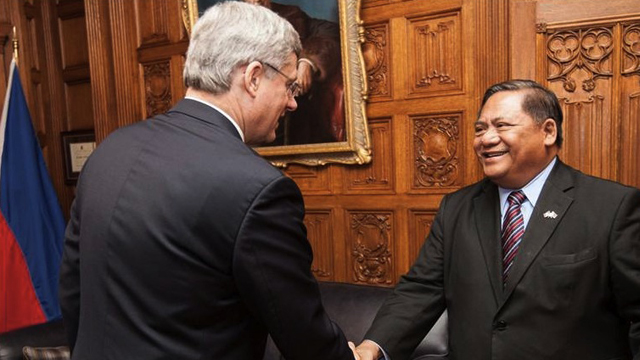SUMMARY
This is AI generated summarization, which may have errors. For context, always refer to the full article.

Stephen Harper, who? Beyond the electric-blue eyes, and his love for hockey, the leader of the Conservative Party remains a polarizing man — one who elicits responses of praise and utter hatred among Canadians.
Since the beginning of his term, he has overseen the adoption of unpopular and controversial policy shifts, including overhauls in the immigration system, that were opposed vehemently by the opposition parties.
The Prime Minister is expected in Manila November 9-10 with a mission to strengthen bilateral ties between the two countries. He is scheduled to meet President Benigno Aquino, with discussions centered mostly on cooperation and the strengthening of economic ties.
This visit is preceeded and will be followed by two other visits to countries/territories which Canada considers crucial: India and Hong Kong. These two jurisdictions are some of Canada’s key trading partners as well as key sources of immigrants.
On the one hand, there’s a palpable sense that the PM’s Manila pit-stop is an affirmation of growing Canadian interest in the Philippines. The latest census data show that Tagalog is the fastest growing native tongue spoken in households across Canada. Let’s pop open a bottle of champagne!
Well, not so fast! Before we get too excited with this development and how we could link it to the Prime Minsister’s visit to the Philippines, we need to take stock of certain realities.

Visit’s importance
With the post-Lehman Brothers realities we are faced, what are the motivating factors pushing the Harper government to finally tip its hat off to the Philippines?
His visit in Manila underscores the importance of opening up critical markets to the Canadian assembly line and resource economy.
It’s no big secret that Canada is relentlessly trying to ween itself from its dependence on the US economy. In 2011, 72% of Canadian exports went to the US.
In the Philippines, we have a saying that if the US sneezes, we catch a cold. In Canada, imagine how it must feel when the US simply clears its throat. While Canada did not suffer as much as the US during the great recession, Canadians did feel the shockwave of the crisis that originated just south of the border.
In other fronts, the Harper government is trying very hard to convince German Chancellor Angela Merkel and the rest of the European chorus that it is in their interest that they sign a free-trade deal with Canada. The EU, without the UK, accounts for 5% of Canadian exports – clearly there’s a lot of room for it to grow.
They are also pushing for an investment treaty between China and Canada – one that aims to increase Chinese investments in Canada, since the former is awash in financial surplus.
As BRIC countries marginally slow down, the growing importance of emerging markets lies in their capacity to maintain a strong domestic economy driven by local production and consumption (as opposed to the old formula of export-led development). This has made economists all over the world, including IMF’s Christine Lagarde, to focus on fairly large populations such as Indonesia and the Philippines (230 million and 100 million respectively).
With its good economic, fiscal and financial fundamentals, this strategic importance has put the Philippines on the map for those who would have normally ignored us.
Even the French
Only quite recently, French Prime Minister Jean-Marc Ayrault was in Manila to strengthen Franco-Philippine relations. The same can be said of France – they are in dire need of export markets. During the recent French presidential elections, one of the critical catch-phrases that dotted the campaign narrative was “made in France.”
Media in the Philippines treated the French Prime Minister’s visit as a general visit to improve bilateral ties. French media on the other hand focused on another angle and was for the most part inaccessible to Filipino readers.
For France, the Philippines represents an opportunity for French exports to offset their reliance on declining markets — i.e., the EU and North America.
We can probably expect less of this undercoverage with Stephen Harper’s overtures to Manila – the Conservative government has made it clear from the start (and in English) that the 3-country mission underscores economic relations above everything else. Already, India and Canada signed agreements relating to trade – mostly in nuclear energy.
Not that Filipino-Canadians can’t take this as an opportunity to leverage a bit of their social capital in Canadian politics. The sad reality is that Filipino-Canadians remain under-represented in Canadian institutions – less than their Filipino American counterparts.
In the history of the Canadian Parliament, only one successfully entered the House of Commons, rising up to become a junior minister. The bad news is, there is not one elected Filipino-Canadian in the House of Commons today. The good news is that the Prime Minister recommended a Filipino-Canadian to sit in the Senate. Sen Tobias Enverga was appointed recently and is the only Filipino-Canadian in federal politics today.
This new-found strength back home may be able to help out Filipinos in Canada. Consider that the Philippines is now Canada’s biggest source of permanent residents, i.e., New Canadians.
Much like how Indian-Canadians rose to prominence in Canada partly on the momentum of a growing Indian economy, perhaps Filipino-Canadians can ride the momentum of a growing Philippine economy and carve out a space for themselves in Canada’s multicultural fabric. – Rappler.com
Add a comment
How does this make you feel?
There are no comments yet. Add your comment to start the conversation.